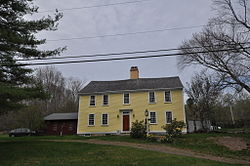
Marshal Jean-Baptiste Donatien de Vimeur, comte de Rochambeau was a French nobleman and general whose army played a critical role in helping the United States defeat the British Army at Yorktown in 1781 during the American Revolutionary War. He was commander-in-chief of the French Expeditionary Force sent by France to help the American Continental Army fight against British forces.
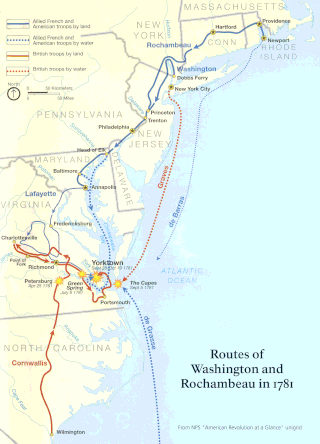
The Washington–Rochambeau Revolutionary Route is a 680-mile (1,090 km) series of roads used in 1781 by the Continental Army under the command of George Washington and the Expédition Particulière under the command of Jean-Baptiste de Rochambeau during their 14-week march from Newport, Rhode Island to Yorktown, Virginia. 4,000 French and 3,000 American soldiers began the march.

The Smithfield Exchange Bank, built in 1822, is located on Putnam Pike in the Greenville area of Smithfield, Rhode Island.
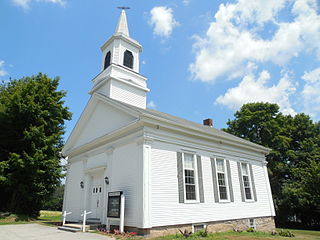
The Sterling Hill Historic District encompasses a well-preserved early 19th-century rural village center on western edge of the town of Sterling, Connecticut. Centered at the junction of Plainfield Pike and Sterling Hill Road, it consists of a cluster of 19th and early 19th-century houses, and a church. Unlike other period villages, it has largely been unaffected by later development. It was listed on the National Register of Historic Places in 1986.

The Newtown Borough Historic District is a 100-acre (40 ha) historic district in the borough of Newtown in Newtown, Connecticut. There is a local historic district and an overlapping district that was listed on the National Register of Historic Places in 1996.
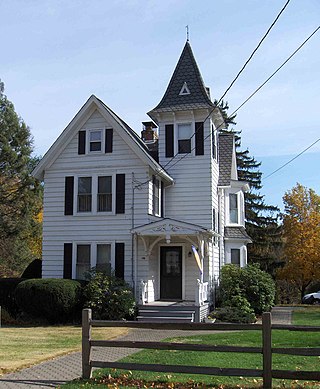
Marion is a neighborhood in the town of Southington, Connecticut. It is generally the area in the vicinity of the intersection of Route 322 and Marion Avenue just north of the Cheshire town line.

The Forty-Seventh Camp of Rochambeau's Army is a historic military camp site in Windham, Connecticut, located along Scotland Road a short way east of Windham Center. It was the site of a French Army camp in November 1782 on their march from the victory at Yorktown to Rhode Island. The camp site is considered of archaeological importance because it can shed light on transient military camp sites, whose locations are not often known. It was listed on the National Register of Historic Places in 2003.
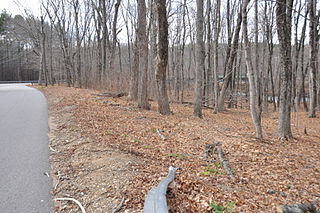
The Fourth Camp of Rochambeau's Army is a historic military camp site near Plains Road and Lovers Lane on the banks of the Shetucket River in Windham, Connecticut. It was here that the French Army encamped in the summer of 1781 under the command of Rochambeau on their march from Providence, Rhode Island to rendezvous with the Continental Army under General George Washington. Four divisions passed through, each one day apart. One of Rochambeau's aides described Windham at the time as "a charming market town, where, incidentally, there were many pretty women at whose homes we passed the afternoon very agreeably." Of the camp site, he wrote, "A mile away is a beautiful river with a fine wooden bridge. We camped on its banks very comfortably, though hardly militarily."

March Route of Rochambeau's Army: Old Canterbury Road is a historic site in Plainfield, Connecticut along the 1781 and/or 1782 march routes of Rochambeau's army. It includes a stretch of what is now Old Canterbury Road and a stretch of Canterbury Road whose environs evoke the period of the Rochambeau army's march. It is a 2-acre (0.81 ha) site that was listed on the National Register of Historic Places in 2003.
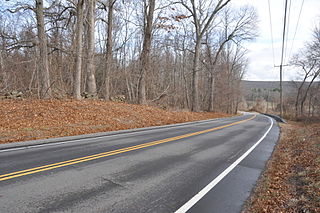
The March Route of Rochambeau's Army: Palmer Road is a linear historic district encompassing a portion of Connecticut Route 14 in eastern Scotland, Connecticut. It was listed on the National Register of Historic Places in 2003 as an evocative surviving element of the march route of the French Army commanded by Rochambeau during the American Revolutionary War in 1781 and 1782.

March Route of Rochambeau's Army: Plainfield Pike is a 3.6 mile-long road segment in Plainfield and Sterling, Connecticut which forms a portion of the historic march route of Comte de Rochambeau's army in June 1781 on its way to Yorktown, Virginia, and again of the returning army in November 1782. It was listed on the National Register of Historic Places (NRHP) in 2003.

The Levi B Frost House, also known as the Asa Barns’ Tavern, is a historic building in the Marion village of Southington, Connecticut. The home represents over two centuries of Southington history. It appears twice on the National Register of Historic Places, as an individual structure and as a part of the Marion Historic District. It is significant both architecturally and historically for its connection to United States and New England history.

The Caleb Baldwin Tavern is a historic house at 32 Main Street in the Newtown Borough Historic District in Newtown, Connecticut, built around 1763. The two-and-a-half-story house is considered historically significant for its role in movement of French Army forces under General Rochambeau, as it housed some of the army's officers in June 1781 on their march to the Siege of Yorktown. It is also an example of traditional 18th-century New England architecture and retains some details from that time period. It was listed on the National Register of Historic Places on August 23, 2002.

Camps No. 10 and 41 of Rochambeau's Army, also known as Site No. 97-87D, is a historical archeological site that was listed on the National Register of Historic Places in 2002. It encompasses the areas occupied by the French Army under General Rochambeau during their marches across Connecticut in 1781 and 1783. One of the major encampment sites is located on the grounds of the Hawley School, where a historic marker is placed.

The March Route of Rochambeau's Army: Hutchinson Road is a 2-acre (0.81 ha) historic road section in Andover, Connecticut. The section of Hutchinson Road, laid out in the early 18th century and formerly an alignment of United States Route 6, formed part of the 1781-82 march routes of Rochambeau's army which contributed to American victory in the American Revolutionary War. It was listed on the National Register of Historic Places in 2002.

White's Tavern is a historic former tavern on United States Route 6 in Andover, Connecticut, built in 1773. It is a well-preserved example of colonial architecture, notable for hosting French Army officers in the American Revolutionary War. It is now a private residence and was listed on the National Register of Historic Places in 1991.
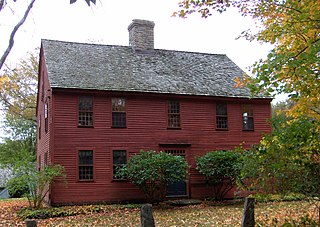
The Oliver White Tavern is a historic former tavern at 2 Brandy Street in Bolton, Connecticut. Built approximately 1750 as a residence, it is a good example of Georgian architecture. The tavern is historically significant because of its association with the march of Rochambeau's army during the American Revolutionary War, on their way to the Battle of Yorktown. The building, now a private residence, was listed on the National Register of Historic Places in 2002.
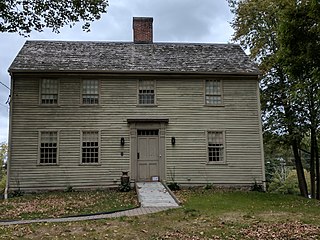
The David Sherman House is a historic house on Middle Quarter Road in Woodbury, Connecticut. Built about 1760, it is a well-preserved example of Colonial architecture. In 1781, David Sherman is reported to have hosted a ball for officers of the French Army of the Comte de Rochambeau during their march across Connecticut. The house was listed on the National Register of Historic Places in 2002.

The Henry Doremus House, also known as the Captain Thomas Doremus House, is a historic stone house located at 490 Main Road in the Towaco section of the township of Montville, New Jersey. The oldest section was built around 1760. It was added to the National Register of Historic Places on October 31, 1972 as the Doremus House for its significance in architecture. It was listed as the Henry Doremus House as part of the Dutch Stone Houses in Montville, New Jersey Multiple Property Submission (MPS) on January 17, 1992.
